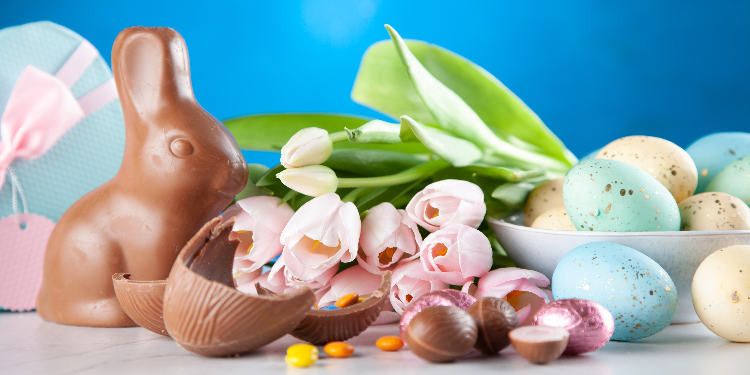
We're currently in the Holy Week until Easter celebrations this Sunday. This holiday is celebrated in many countries around the world, but with different traditions. The COVID-19 crisis is affecting celebrations for the second year in a row, but this is what Easter looks like in normal times.
Easter in Europe
Easter, which stems from the Christian tradition, is usually celebrated grandly in most European countries. Still, besides the Easter mass and family gatherings, the customs vary.
In France, for example, you won't hear church bells ring from Thursday to Sunday, the day of Christ's resurrection. After the mass, children start egg-hunting. Chocolates of all colours and shapes (can be eggs, chickens or rabbits) are hidden in the gardens. Families then gather around the traditional lunch, usually consisting of roast lamb and vegetables. In Corsica, it is customary to eat roast goat for Easter. The dessert consists of a large brioche crown decorated with hard-boiled eggs. It brings good luck!
In Italy, Easter Monday is even more special. Of course, families get together in a friendly atmosphere on Easter Day. But they'll eat the Easter eggs during a family picnic the next day. In some Italian cities, such as Milan, the "colomba" is the traditional cake. It is baked in the shape of a dove, symbolising peace. In other cities, people usually gather to watch spectacular fireworks.
In Spain, Easter isn't just about mass, family gatherings and chocolate! In some cities, like in Andalusia, masked processions are held during the Holy Week. On the occasion, chariots are made, and people wearing long dresses and rather disturbing conical hats walk along the streets holding the Holy Cross. It's quite similar in Portugal, where priests roam the village streets to bless families. There are also colourful parades and theatre performances. If you're in Portugal for Easter, you might also get the opportunity to taste the “folar de Pascoa”, a traditional cake.
In Germany, Easter celebrations are slightly different. Children usually decorate a vine or a leafless tree that symbolises the Easter tree with colourful eggs. They also hide little straw nests around the house, waiting for the Easter Bunny to fill them with chocolate eggs. The Easter meal in Germany comprises vegetables on Thursday, fish on Good Friday and lamb on Easter's eve.
In England, Easter looks more like Halloween. Indeed, children roam around the neighbourhood to collect egg-shaped chocolates and other delicacies. Easter meal consists of roast lamb, as in many European countries, accompanied by a mint sauce and potatoes and peas. Dessert comprises small sweet brioches decorated with a cross and filled with candied fruits.
In Greece, people fast on Good Friday. On Saturday, they have tripe soup along with traditional bread and hard-boiled eggs dyed red as a symbol of the blood of Christ. On Easter Day, they will have roast lamb with rice and salad, and often liver balls. Russian families also have lamb for Easter but oven-baked with butter and ham. They have “kulish”, a cake made from cottage cheese and candied fruits and flavoured with saffron for dessert. However, it must be blessed by the priest in church before it is eaten.
A stunning Easter custom in Russia is that people visit their deceased relatives' graves to eat hard-boiled eggs and leave them some.
Easter in Scandinavia
In Sweden, Easter looks like Halloween. On Thursday, children dress up as witches and roam around the neighbourhood to collect candy. As they receive treats, they offer adults decorated willow branches or colourful drawings. On Easter Sunday, Swedes usually gather around a large bonfire to chase witches away. In Sweden, as in Norway and Finland, people have the traditional lamb and salmon or herring, a bread made with rye and malt flour and decorated with cream, sugar. Cake made from curdled milk and candied fruit, chocolate eggs and brioches are also served.
Elsewhere in the world
Easter traditions around the world are unique and very often surprising. In Mexico, for example, the streets are decorated two weeks days before Easter. On Easter Eve, people usually get together in the streets to burn representations of Judas and destroy pinatas bearing his image before feasting on the fallen sweets. Easter lunch or dinner comprises fish and seafood.
In the Philippines, Easter customs can be shocking for those who are unfamiliar with them. During Holy Week, processions and theatre performances are held in the streets. You will often see people self-flagellate or crucify themselves during these processions. This is their way to demonstrate the pain of Christ. On Easter Day, Filipinos take palm leaves to church for blessings and then use them to decorate their homes.
El Salvador has one of the world's weirdest Easter traditions. During the Holy Week, men get disguised as the devils and roam the streets, whipping random spectators. This parade symbolises Christ's struggle against temptation. When the procession ends, they collapse on the ground and lie down under the scorching sun until their families come to sprinkle water on them so that they don't faint.
If you're shocked, have a look at two rather simple and fun Easter customs. In Poland, for example, people indulge in the "Śmigus Dyngus", or water battle on Easter Monday. In Bermuda, people fly kites for Easter. In normal times, the traditional annual kite festival is held on Good Friday.




















Comments
1